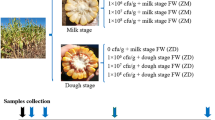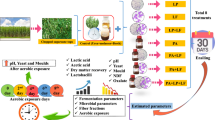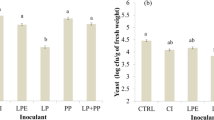Abstract
The aim of this work was to study the effects of applying a strain of Propionibacterium acidipropionici, with or without Lactobacillus plantarum, on the fermentation and aerobic stability characteristics of low dry matter (DM) corn (Zea mays L.) and sorghum (Sorghum bicolor L.) silages. Corn at the dent stage and sorghum at the flowering stage were harvested. Treatments comprised control (no additives), P. acidipropionici, L. plantarum and a combination of P. acidipropionici and L. plantarum. Fresh forages were sampled prior to ensiling. Bacterial inoculants were applied to the fresh forage at 1.0×106 colony-forming units per gram. After treatment, the chopped fresh materials were ensiled in 1.5-l anaerobic glass jars equipped with a lid that enabled gas release only. Three jars per treatment were sampled on days 2, 4, 8, 16 and 60 after ensiling, for chemical and microbiological analysis. At the end of the ensiling period, 60 days, the silages were subjected to an aerobic stability test. The L. plantarum inoculated silages had significantly higher levels of lactic acid than the controls, P. acidipropionici and combination of P. acidipropionici and L. plantarum inoculated silages (P<0.05). The P. acidipropionici did not increase propionic and acetic acid levels of the silages. After the aerobic exposure test, the L. plantarum and combination of P. acidipropionici and L. plantarum had produced more CO2 than the controls and the silages inoculated with P. acidipropionici (P<0.05). All silages had high levels of CO2 and high numbers of yeasts and molds in the experiment. Therefore, all silages were deteriorated under aerobic conditions. The P. acidipropionici and combination of P. acidipropionici and L. plantarum were not able to improve the aerobic stability of fast-fermenting silages, because they could not work well in this acidic environment. The results showed that P. acidipropionici and combination of P. acidipropionici and L. plantarum did not improve the aerobic stability of low DM corn and sorghum silages, which are prone to aerobic deterioration.

Similar content being viewed by others
References
Woolford MK (1990) The detrimental effects of air on silage. J Appl Bacteriol 68:101–116
Pitt RE, Liu Y, Muck RE (1991) Stimulation of the effect of additives on aerobic stability of alfalfa and corn silages. T ASAE 34:1633–1641
Ashbell G, Weinberg ZG, Hen Y, Filya I (2002) The effects of temperature on the aerobic stability of wheat and corn silages. J Ind Microbiol Biot 28:261–263
Filya I, Ashbell G, Hen Y, Weinberg ZG (2000) The effect of bacterial inoculants on the fermentation and aerobic stability of whole crop wheat silage. Anim Feed Sci Tech 88:39–46
Filya I (2002) The effects of lactic acid bacterial inoculants on the fermentation, aerobic stability, and in situ rumen degradability characteristics of maize and sorghum silages. Turk J Vet Anim Sci 26:815–823
Filya I (2003) The effect of Lactobacillus buchneri and Lactobacillus plantarum on the fermentation, aerobic stability, and ruminal degradability of low dry matter corn and sorghum silages. J Dairy Sci 86:3575–3581
Weinberg ZG, Ashbell G, Hen Y, Azrieli A (1993) The effect of applying lactic acid bacteria at ensiling on the aerobic stability of silages. J Appl Bacteriol 75:512–518
Moon NJ (1983) Inhibition of the growth of acid tolerant yeasts by acetate, lactate and propionate and their synergistic mixtures. J Appl Bacteriol 55:454–460
Wohlt JE (1989) Use of silage inoculant to improve feeding stability and intake of a corn silage-grain diet. J Dairy Sci 72:545–551
Pahlow G, Honig H (1994) The role of microbial additives in the aerobic stability of silage. In: Workshop proceedings of the 15th general meeting of the European grassland federation. Netherlands society for grassland fodder crops, Wageningen, pp 149–151
Bolsen KK, Bonilla DR, Huck GL, Young MA, Hart-Thakur RA (1996) Effect of propionic acid bacterial inoculant on fermentation and aerobic stability of whole-plant corn silage. In: Report of progress of Kansas state university agricultural experiment station. Kansas state university, Manhattan, pp 78–81
Filya I, Sucu E, Karabulut A (2004) The effect of Propionibacterium acidipropionici, with or without Lactobacillus plantarum, on the fermentation and aerobic stability of wheat, sorghum and maize silages. J Appl Microbiol 97:818–826
Weinberg ZG, Ashbell G, Bolsen KK, Pahlow G, Hen Y, Azrieli A (1995) The effect of a propionic acid bacterial inoculant applied at ensiling, with or without lactic acid bacteria, on the aerobic stability of pearl millet and corn silages. J Appl Bacteriol 78:430–436
Weinberg ZG, Ashbell G, Hen Y, Azrieli A (1995) The effect of propionic acid bacterial inoculant applied at ensiling on the aerobic stability of wheat and sorghum silages. J Ind Microbiol Biot 15:493–497
Higginbotham GE, DePeters EJ, Mueller SC (1996) Effect of propionic acid producing bacteria on corn silage fermentation. Prof Anim Sci 12:176–180
Higginbotham GE, Mueller SC, Bolsen KK, DePeters EJ (1998) Effects of inoculants containing propionic acid bacteria on fermentation and aerobic stability of corn silage. J Dairy Sci 81:2185–2192
Ashbell G, Weinberg ZG, Azrieli A, Hen Y, Horev B (1991) A simple system to study the aerobic deterioration of silages. Can Agr Eng 34:171–175
Dubois M, Giles KA, Hamilton JK, Rebes PA, Smith F (1956) Colorimetric method for determination of sugars and related substances. Anal Chem 28:350–356
Barker SB, Summerson WH (1941) The colorimetric determination of lactic acid in biological material. J Biol Chem 138:535–554
Weinberg ZG, Ashbell G, Hen Y, Azrieli A, Szakacs G, Filya I (2002) Ensiling whole-crop wheat and corn in large containers with Lactobacillus plantarum and Lactobacillus buchneri. J Ind Microbiol Biot 28:7–11
Pahlow, G (1991) Role of microflora in forage conservation. In: Pahlow G, Honig H (eds) Proceedings of a conference on forage conservation towards 2000. Institute of grassland and forage research, Braunschweigh, pp 26–36
Acknowledgements
This work was supported by the Uludag University, Bursa, Turkey, Project No. 2002/20.
Author information
Authors and Affiliations
Corresponding author
Rights and permissions
About this article
Cite this article
Filya, I., Sucu, E. & Karabulut, A. The effects of Propionibacterium acidipropionici and Lactobacillus plantarum, applied at ensiling, on the fermentation and aerobic stability of low dry matter corn and sorghum silages. J IND MICROBIOL BIOTECHNOL 33, 353–358 (2006). https://doi.org/10.1007/s10295-005-0074-z
Received:
Accepted:
Published:
Issue Date:
DOI: https://doi.org/10.1007/s10295-005-0074-z




